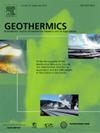Integrated geological and 2D electrical resistivity tomography for assessment of geothermal potential in Dilla area, Southern Main Ethiopian Rift
IF 3.9
2区 工程技术
Q3 ENERGY & FUELS
引用次数: 0
Abstract
This study aims to assess the geothermal potential in the Dilla area, Southern Main Ethiopian Rift using integrated geological mapping and electrical resistivity tomography (ERT) technique. The ERT survey profiles were conducted around the six hot spring sites to examine the subsurface geological units and structures that suggest the presence of shallow geothermal systems based on Wenner electrode array type configuration. Geologically, silicic volcanic rocks and hot springs are predominantly concentrated in the western region, in which hot springs aligned along north south trending fault lines with discharge temperatures ranges from 25 °C to 80 °C. The ERT surveys conducted around Bersiso, Dilla University, and Odomike profiles indicates zone of low resistivity (< 200 Ω·m) beginning at approximately 15 m depth and continuing downward corresponds to shallow geothermal reservoirs. These layers are overlain by impermeable cap rocks which exhibiting high resistivity values (>1500 Ω·m). The finding of this study reveal that hot springs are mainly situated along the east-dipping normal faults that act as conduits for the upward migration of geothermal fluids possibly from shallow heat source. The analysis result of the ERT was cross-checked with the lithological logs and indicates reliable output showcasing the applicability of the techniques for shallow geothermal exploration. The study suggest that the geothermal potential zones are mainly concentrated along fault zones highlighting Odomike and Bersiso hot spring sites could be applicable for geothermal development.
埃塞俄比亚主裂谷南部Dilla地区地热潜力综合地质和二维电阻率层析成像评估
本研究旨在利用综合地质填图和电阻率层析成像(ERT)技术评估埃塞俄比亚主裂谷南部Dilla地区的地热潜力。ERT测量剖面在六个温泉点周围进行,以检查地下地质单元和结构,这些地质单元和结构表明存在基于Wenner电极阵列型配置的浅层地热系统。地质上,西部主要集中了硅质火山岩和温泉,温泉沿南北走向的断裂带排列,流出温度在25℃~ 80℃之间。在Bersiso、Dilla University和Odomike剖面附近进行的ERT调查显示,该区域存在低电阻率(<;200 Ω·m),从大约15 m深度开始,继续向下对应于浅层地热储层。这些层被不渗透盖层覆盖,具有高电阻率值(>1500 Ω·m)。研究结果表明,温泉主要分布在东倾正断层上,为地热流体的向上运移提供了通道,可能来自浅层热源。ERT分析结果与岩性测井资料进行了对比,结果可靠,显示了该技术在浅层地热勘探中的适用性。研究认为,该区地热潜力带主要集中在断裂带沿线,尤以Odomike和Bersiso温泉为重点,可进行地热开发。
本文章由计算机程序翻译,如有差异,请以英文原文为准。
求助全文
约1分钟内获得全文
求助全文
来源期刊

Geothermics
工程技术-地球科学综合
CiteScore
7.70
自引率
15.40%
发文量
237
审稿时长
4.5 months
期刊介绍:
Geothermics is an international journal devoted to the research and development of geothermal energy. The International Board of Editors of Geothermics, which comprises specialists in the various aspects of geothermal resources, exploration and development, guarantees the balanced, comprehensive view of scientific and technological developments in this promising energy field.
It promulgates the state of the art and science of geothermal energy, its exploration and exploitation through a regular exchange of information from all parts of the world. The journal publishes articles dealing with the theory, exploration techniques and all aspects of the utilization of geothermal resources. Geothermics serves as the scientific house, or exchange medium, through which the growing community of geothermal specialists can provide and receive information.
 求助内容:
求助内容: 应助结果提醒方式:
应助结果提醒方式:


